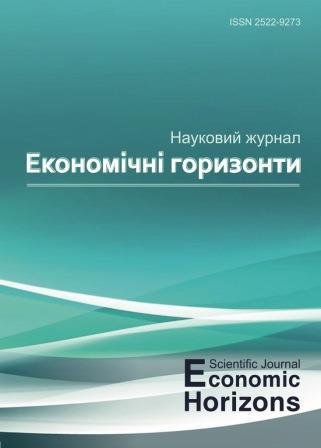КОНЦЕПЦІЯ ЦИФРОВОЇ ІНКЛЮЗІЇ: СУТНІСТЬ, ФАКТОРИ, ЕЛЕМЕНТИ
DOI:
https://doi.org/10.31499/2616-5236.3(21).2022.263631Ключові слова:
інформаційна безпека, цифрова інклюзія, цифровий розрив, цифрова дискримінація, цифрова грамотністьАнотація
Інформаційна безпека країни формується під впливом значної кількості різноспрямованих факторів, одним з яких є високий рівень цифрової інклюзії населення. Метою статті є уточнення розуміння концепту «цифрова інклюзія» та систематизації її елементів з урахуванням особливостей та факторів впливу. У статті використано теоретичний підхід, що містить систематичний, логічний та порівняльний аналіз та синтез наукової літератури, присвяченої концепціям цифрової інклюзії та цифрового розриву. Визначено, що рівень цифрової інклюзії є визначальним фактором формування інформаційної безпеки країни через підвищення рівня освіченості населення, що зменшує інформаційні загрози комунікативного характеру (негативні інформаційні впливи).
Посилання
A National Digital Inclusion Roadmap. Australian Digital Inclusion Alliance (2020). Retrieved from:: https://www.digitalinclusion.org.au/wp-content/uploads/2020/10/ADIA-A-National-Digital-Inclusion-Roadmap.pdf.
Abdul, A. (2020). Digital inclusion challenges in Bangladesh: the case of the National ICT Policy. Contemporary South Asia, 28:3, 304-319. doi.org/10.1080/09584935.2020.1793912.
Ali, М. А, Alam, К., Taylor, B., Rafiq, S. (2020). Does digital inclusion affect quality of life? Evidence from Australian household panel data. Telematics and Informatics, 51. doi.org/10.1016/j.tele.2020.101405.
Aslam, A., Naveed, A., Shabbir, G. (2021). Is it an institution, digital or social inclusion that matters for inclusive growth? A panel data analysis. Qual Quant, 55, 333-355. doi.org/10.1007/s11135-020-01008-3.
Becker, S., Crandall, M., Coward, C., Sears, R., Carlee, R., Hasbargen, K., & Ball, M. A. (2012). Building digital communities: A framework for action. Institute of Museum and Library Services.. Retrieved from: https://www.imls.gov/sites/default/files/publications/documents/buildingdigitalcommunitiesframework.pdf.
Beyi, W. A. (2018). The Trilogy of a Digital Communication between the Real Man, His Digital Individual and the Market of the Digital Economy. SocioEconomic Challenges, 2(2), 66-74. doi.org/10.21272/sec.2(2).66-74.2018.
Csaba, K., Bellász, Z. V. (2017). Terrorism and the information security of media content with special regard to ISIS, the Balkans and Russia. SocioEconomic Challenges, 1(1), 13-19.
Digital Inclusion definition, Retrieved from:https://digitalinclusion.nz/about/digital-inclusion-definition.
Graham M. Time machines and virtual portals: The spatialities of the digital divide. Progress in Development Studies. 2011. № 11 (3). Р. 211-227. URL: doi:10.1177/146499341001100303 (accessed 27.02.2021).
Hanke, F. (2021). Digital Inclusion. IGFWiki. Retrieved from: https://intgovwiki.org/w/index.php/Digital_Inclusion.
Helsper, E. (2008). Digital inclusion: an analysis of social disadvantage and the information society. Department for Communities and Local Government. Retrieved from: http://eprints.lse.ac.uk/26938/.
Hilbert, M. (2010). When is Cheap, Cheap Enough to Bridge the Digital Divide? Modeling Income Related Structural Challenges of Technology Diffusion in Latin America. World Development, 38 (5), 756-770. doi:10.1016/j.worlddev.2009.11.019.
Lyeonov, S., Кuzmenko, О., Yarovenko, H., Dotsenko, T. (2019). The Innovative Approach to Increasing Cybersecurity of Transactions Through Counteraction to Money Laundering. Marketing and Management of Innovations, 3, 308-326. doi.org/10.21272/mmi.2019.3-24.
Milon, K., Nur-Al-Ahad, Md., Monjurul Alam, A.B.M. (2018). The Deployment of Next Generation Access Network in the EU: Facts and Analysis of Regulatory Issues. Business Ethics and Leadership, 2(4), 6-17. http://doi.org/10.21272/bel.2(4).6-17.2018.
Miroshnichenko, I., Morozova, E., Meshcheryakova, E. (2020). Policy for Overcoming Digital Inequality: Structure, Actors and Technologies. 6th International Conference on Economics, Management, Law and Education (EMLE 2020). https://doi.org/10.2991/aebmr.k.210210.065.
Morato, J., Ruiz-Robles, A, Sanchez-Cuadrado, S., & Marzal, M. A. (2020). Technologies for digital inclusion: Good practices dealing with diversity. In: Wealth Creation and Poverty Reduction: Breakthroughs in Research and Practice. IGI Global, 17-37.
Morganti, L., Helberger, N., Mariën, I., & Prodnik, J. A. (2014). Digital inclusion and user (dis) empowerment: A critical perspective, Vol. 16, Iss. 6, 35-47. Retrieved from: https://www.emerald.com/insight/content/doi/10.1108/info-07-2014-0030/full/html.
Muñoz, L. A., Bolívar, M. P. R., Alcaraz-quiles, F. J. (2016). Policies and strategies for digital inclusion: Regional governments in Spain. In: Handbook of research on race, gender, and the fight for equality, IGI Global, 1-29.
Pereira, J. (Ed.). (2010). Handbook of research on personal autonomy technologies and disability informatics. IGI Global.
Race Online 2012 and PriceWaterhouseCoopers. Champion for Digital Inclusion: The Economic Case for Dіgital Inclusion. October 2009. Retrieved from: http://ict-industry-reports.com.au/wp-content/uploads/sites/4/2013/10/2009-Economic-Case-for-Digital-Inclusion-PWC-UK-Oct-2009.pdf.
Rejas-Muslera, R. J., García-Tejedor, A. J., & Rodriguez, O. P. (2011). Open Educational Resources in E-Learning: Standards and Environment. In Handbook of Research on E-Learning Standards and Interoperability: Frameworks and Issues (pp. 346-359). IGI Global.
Szeles, M. R., Simionescu, M. Regional patterns and drivers of the EU digital economy. (2020). Social Indicators Research, 150(1), 95-119. doi.org/:10.1007/s11205-020-02287-x
Wessels, B. (2010). E-inclusion: European perspectives beyond the digital divide. In: Encyclopedia of e-business development and management in the global economy, IGI Global, 1068-1075.
Yarovenko, H., Kuzmenko, O., Stumpo, M. (2020). DEA-Analysis Of The Effectiveness Of The Country’s Information Security System. SocioEconomic Challenges, 4(3), 142-153. https://doi.org/10.21272/sec.4(3).142-153.2020.
Yarovenko, H., Kuzmenko, O., Stumpo, M. (2020). Strategy for Determining Country Ranking by Level of Cybersecurity. Financial Markets, Institutions and Risks, 4(3), 124-137. https://doi.org/10.21272/fmir.4(3).124-137.2020.
Yarovenko, H. (2020). Evaluating the threat to national information security. Problems and Perspectives in Management, 18(3), 195-210. doi.org/10.21511/ppm.18(3).2020.17.
Yu, B., Ndumu, A., Mon, L. M., Fan, Z. (2018). E-inclusion or digital divide: an integrated model of digital inequality. Journal of Documentation, 74. doi.org/10.1108 / JD-10-2017-0148.
Zacher, L. W. (2010). Sociocultural Context of E-Government Readiness: Selected Problems. In Handbook of Research on E-Government Readiness for Information and Service Exchange: Utilizing Progressive Information Communication Technologies (pp. 70-86). IGI Global.
Nosenko, Y. (2016). Elektronna inklyuziya yak efektyvna stratehiya zabezpechennya dostupnosti ta vidkrytosti osvity [Electronic inclusion as an effective strategy for ensuring the accessibility and openness of education]. Pedahohichni innovatsiyi: ideyi, realiyi, perspektyvy, 2, 116-123 [in Ukrainian].
##submission.downloads##
Опубліковано
Як цитувати
Номер
Розділ
Ліцензія

Ця робота ліцензується відповідно до Creative Commons Attribution-NonCommercial 4.0 International License.




